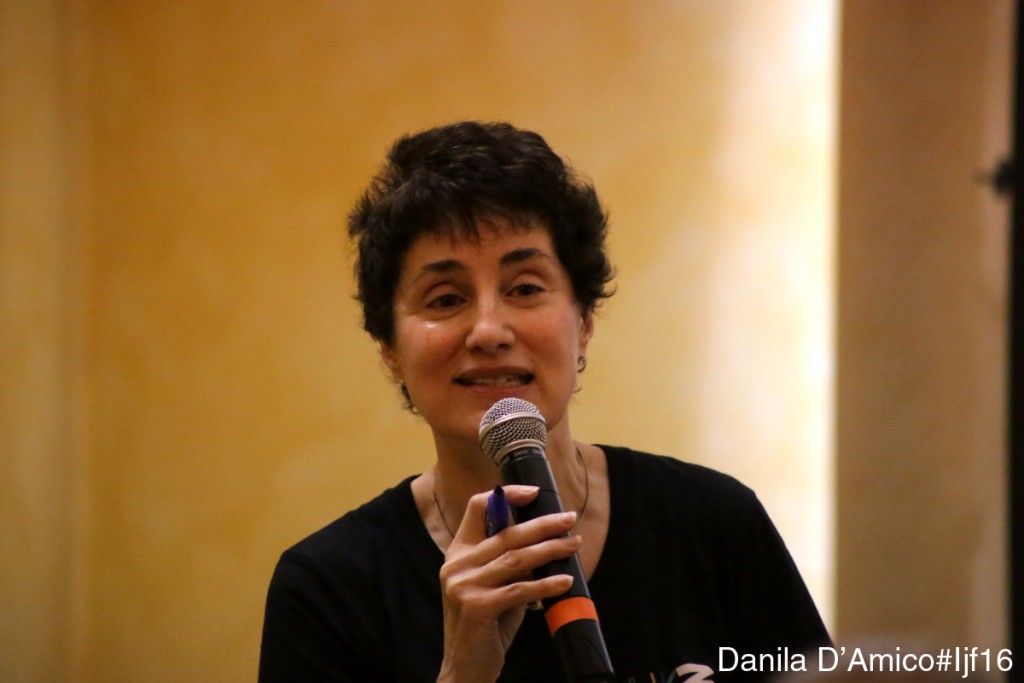Few people seem better equipped to teach an audience about video storytelling than Marsha Barber. Her impressive CV spans working as the senior producer at CBC’s flagship newscast The National, freelance journalism, running workshops for producers internationally and, if that wasn’t enough, writing poetry for which she’s been shortlisted for an international award.
Her passion for communication became clearer still as she excitedly answered her own question “Why are stories so important?”. She explained that for her they are the most phenomenal way of engaging others: briefly nodding to storytelling’s long history and admitting it was nothing new, she stated that what was exciting about it was its marriage to television. Communicating insight and information through stories is given more capabilities still when combined with the immediacy and visuals that television as a medium brings. According to Barber television actually has the ability to turn viewers into eye witnesses despite watching from the comfort of your own home. Citing the 2004 Tsunami as an example, the well taken and structured footage actually facilitated the emotional investment of people on the other side of the world.
Beginning by emphasising the sheer amount of choice we have regarding where we receive our information from, Barber was clear that it is vital that we must always keep audiences in mind in order to engage with them properly. According to her, this must always be a priority.
In order to do so, she suggested attendees to imagine a bad harvest and to try and undertstand the mindset of the average audience, wondering “Why should I care? How does this connect to my life?”. With this in their minds, Barber discussed the interest surrounding the human cost of a crop failure, as opposed to statistics and analysis about complicated farming methods. Before asking the attendees which they would find more interesting, she shared a story of the human cost of agriculturally-driven hardship. The story involved a hard-working farming family whose crops were affected and struggling to financially survive. Despite their desperation, they were determined to pay for their daughter’s college fees. Then, encouraged by the audience’s leaning in closer, she surprised them by beginning to explain how a basic tool for good story telling could be illustrated using the parallel of a fairytale.
In a fairytale, there’s normally a protagonist and an end goal. Drawing a vertical line down a big A3 pad, she placed the Prince at the bottom and a beautiful Princess at the top. The space on the right hand side of the line she titled “Hinderers” and the left hand side of the line “Helpers”: the slightly baffled public were then asked for the suggestions of characters or qualities that fit in each respective section. Before long, terms such as “good looks,” “the King and Queen,” and, with a nod to Barber’s Canadian roots, “Justin Trudeau hair” began to appear on the left side. Terms like “evil Dragon” “Witch” and “Drug habit” on the right.
Barber proceeded to explain that this diagrammatic technique was called the “Narrative Table” and was regularly used in training sessions at the CBC and elsewhere. Segueing neatly back into the agricultural story, both audience and speaker then discussed how the helpers could be “NGOs”, a “supportive community,” and hinderers perhaps “poor weather”, “high college fees” and “poverty”. When combined with fitting the family as the protagonist in the story structure, and “sending daughter to college” as the goal, a clear narrative table was created to establish good story telling.
While clearly a very effective model, this form of storytelling could however lead to sensationalism and therefore affect the truth. When questioned on the matter, Barber replied saying that it was indeed a “concern to be aware of,” but that it ultimately was a “journalistic duty to always be factually accurate,” just “within an interesting and factual format.”
Barber later explained simpler yet still vital methods to structure a memorable story. Firstly, always have a focus: in essence, journalists should be able to have a question at the outset, and a conclusion by the end. She emphasised the value of succinctness and warned against lengthening pieces for the sake of being longer as opposed to adding journalistic value. A way to ensure staying on track in a structured, but simple way, is the adoption of the “Arc of Tension,” a concept and diagram illustrating that not only must a story have a beginning, middle and end, but also a build up to the highest point of tension and a return to an equal lower point.
Despite racing against the clock to finish, Barber extended this further by drawing what she named “The Whale”. The most appropriate description of this would be a slightly more voluptuous and annotated version of the Arc of Tension, beginning with the hook of the story and featuring the development, climax and wrap as well.
